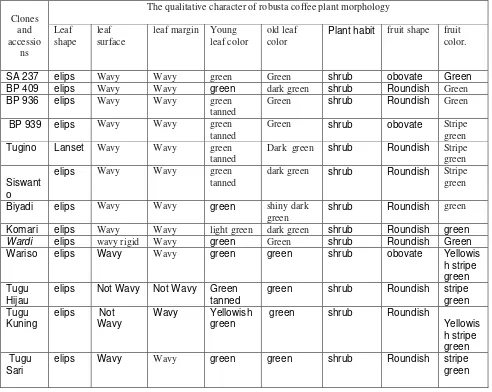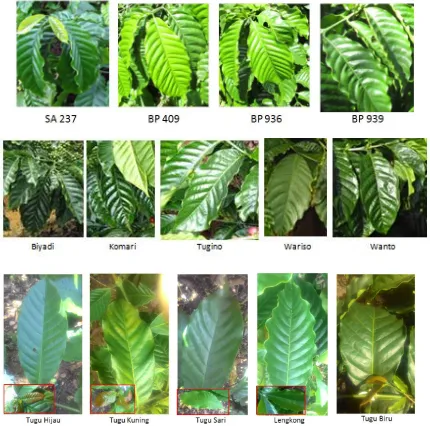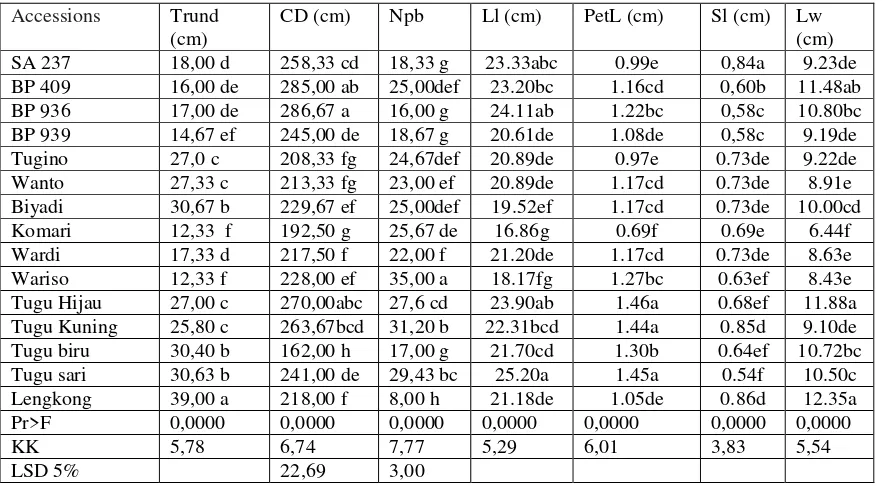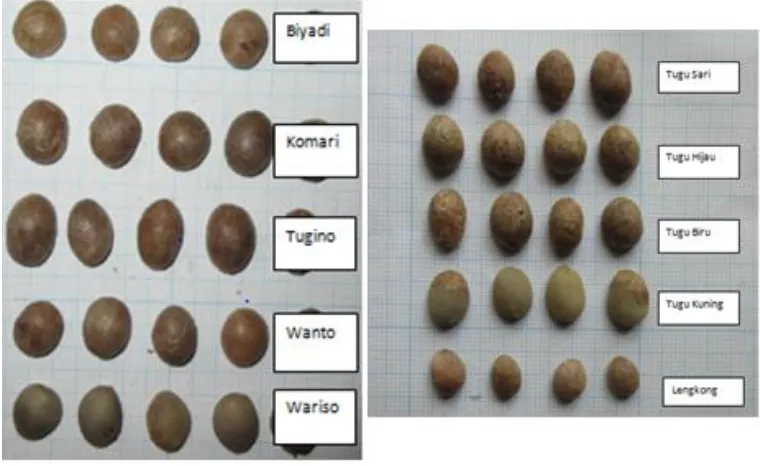Morphological VariationAmong Fifteen Superior Robusta Coffee Clones In Lampung Province, Indonesia
Keragaman Morfologi Pada Limabelas Klon Kopi Robusta Unggul Di Propinsi Lampung, Indonesia
Sri Ramadiana*1), Dwi Hapsoro*) dan Yusnita*)
1
) Corresponding author.
*) Faculty of Agriculture, University of Lampung, Jl. Sumantri Brojonegoro No. 1 Bandar Lampung; E-mail: sriramadiana@fp.unila.ac.id. dwi.hapsoro@fp.unila.ac.id,
yusnita.1961@fp.unila.ac.id.
Abstrak
This study was aimed to characterize morphological variation among fifteen superior robusta coffee clones in Lampung Province. The fifteenclones observed consisted of four clones released
by Indonesian Coffee and Cocoa Research Institute (ICCRI), i.e., ‘BP 409’,‘BP936’, ‘BP939’,
‘SA 237’ and eleven superior coffee clones selected by farmers from Tanggamus district
(‘Tugino’,‘Siswanto’, ‘Biyadi’, ‘Komari’, ‘Wardi’, ‘Wanto’) and from West Lampung district
(‘TuguKuning’, ‘TuguHijau’, ‘TuguBiru’,‘Tugu Sari’, ‘Lengkong’).The morphological characterization was evaluated on the basis of fifteen qualitative characters and seven quantitative characters, in a randomized complete block design, using three replicates for each clones. The results showed that there were some similarities and differences in morphological characters among the fifteen coffee clones. The similaritieswere found in some qualitative morphological characters, i.e., shapes of leaf base and leaf tip, petiole colors, leaf venation patterns,fruit disk shapes, ripe-fruit colors and stipule shapes, while variation was observed in shape of leaf lamina (elliptical vs. lanceolate), fruit shapes (roundvs.oval) and shape leaf margins. Morphological variation were also observed in some quantitative characters, namely canopy diameters, tallness of the tree, stem diameters, leaf lengths, leaf widths, petiole lengths, stipule lengths and number of primary branches.
INTRODUCTION
Robusta coffee is the most widely cultivated coffee in Indonesia. Province Lampung is the largest producer of robusta coffee in Indonesia, with 161,693 ha of planting area, 110.318 tons of productivity and 1,004 kg / ha productivity (.Directorate General of Estate Crops, 2015). The main centers of robusta coffee plantations in Lampung include districts West Lampung and Tanggamus. Huitema 1935 in Verbist 2000 said that in 1880, coffee commodities have been known in Sukajaya village, Sumber Jaya district of West Lampung (Community Georaphical Indication, 2013).
Robusta coffee develops as an introduction plant that has the highest variability in the genus Coffea (Cubry, et al., 2008, Motta, et al, 2014). Robusta coffee is a cross-pollinated species so the resulting population will be heterozygous. Robusta diversity is very large both in terms of morphology, ecological size and adaptation (Anthonny et al, 2007, Missio et al, 2011). The morphological differences are the easiest to see, especially in mature plants.
Development and distribution of coffee plants in farming communities in Lampung are still using planting materials from seeds that are believed to have high production. The farmer will select a superior coffee plant in his garden and spread it to another farmer's garden. This pattern of coffee spread leads to the emergence of new genotypes with diverse phenotypic characters. Currently the names of recognized local clones by farmer. Therefore it is necessary to characterize the diversity of the local superior clone phenotype of Lampung and compared with the well-adapted National clone in Lampung.
Identification of robusta coffee accession is important to know genetic diversity and crop potential in certain areas. Today, methods for discovering different genetic diversities can use morphological, biochemical and molecular markers (Maluf, et al, 2005; Achar, et al, 2015; Evizal, et al., 2015). Of these three techniques, morphological identification is the oldest and simplest. Morphological characterization is the first step in the description and classification of germplasm. Although morphological characterization is relatively ineffective for genetic diversity analysis because the appearance of plants is strongly influenced by environmental factors (Sumirat, 2016; ). However, this method is still widely used to estimate species diversity. In addition, morphological characterization and data collection of coffee plants from a particular region is helpful in studying the evolutionary relationship in line with the history of plants in the region.
This study aims to determine the diversity of morphological characters from 15 types of robusta coffee superior to the selection of farmers in Lampung province.
MATERIALS AND METHODS
subdistricts. The geographical location of West Lampung district lies between 4 ° 47`16 "- 5 ° 56`42" south latitude and 103 ° 35`8 "- 104 ° 33`51" east longitude at an altitude of 986 meters above sea level ( Fig.1). Exploration was done by observation collecting field data through observation of type of robusta coffee which was widely grown in farmers Recording data by selecting 4 selected plants from each of the duplicate accessions. Qualitative observation of morphological characters of each accession include: leaf base, petiole color, stipulated color, leaf shape, leaf venation pattern, leaf shape, leaf surface, leaf margin, young leaf color, old leaf color, fruit color, ripe fruit color.
Figure 1. Map of robusta coffee planting area Lampung
RESULTS AND DISSCUSSION
Identification and characterization of the local superior robusta coffee mosaic of robusta Lampung and the national superior clone.
Observations were made on the coffee plant in Edufarm Nestle, the farmers' coffee garden in Ulubelu Tanggamus sub-district and the coffee farmer's garden in Sumber Jaya Sub-district, West Lampung District. In this activity have been identified morphological characteristic of 15 robusta coffee genotypes, consisting of 4 national superior clones of SA 237, BP 409, BP 936, BP 939 and 11 local superior accession Lampung namely Tugino, Wanto, Biyadi, Komari, Wardi, Tugu Kuning, Tugu Hijau, Tugu Sari, Tugu biru and Lengkong. Some qualities of coffee morphology are the same. Characters are the shape of the base of the leaf, the shape of the tip of the leaf, the pattern of leaf bone, petiole color, form of fruit diskus, the color of ripe fruit and stipula form (Fig. 2).
Table 1. Diversity of qualitative qualities of plant morphology of various clones and accessions of local robusta coffee Lampung
Clones and accessio
ns
The qualitative character of robusta coffee plant morphology
Leaf
Plant habit fruit shape fruit color.
SA 237 elips Wavy Wavy green Green shrub obovate Green BP 409 elips Wavy Wavy green dark green shrub Roundish Green BP 936 elips Wavy Wavy green
tanned
Green shrub Roundish Green
BP 939 elips Wavy Wavy green tanned
Green shrub obovate Stripe green Tugino Lanset Wavy Wavy green
tanned
Dark green shrub Roundish Stripe green
Siswant o
elips Wavy Wavy green tanned
dark green shrub Roundish Stripe green
Biyadi elips Wavy Wavy green shiny dark green
shrub Roundish green
Komari elips Wavy Wavy light green dark green shrub Roundish green
Wardi elips wavy rigid Wavy green Green shrub Roundish Green
Wariso elips Wavy Wavy green green shrub obovate Yellowis h stripe
green shrub Roundish stripe green
Tugu Biru
elips Wavy Wavy Green tanned
green shrub obovate Green
Lenggk ong
elips Wavy Wavy green tanned
green shrub Roundish Green
Table 2. Diversity of morphological quantitative characters of various accessions of local robusta coffee Lampung
Accessions Trund (cm)
CD (cm) Npb Ll (cm) PetL (cm) Sl (cm) Lw (cm) SA 237 18,00 d 258,33 cd 18,33 g 23.33abc 0.99e 0,84a 9.23de BP 409 16,00 de 285,00 ab 25,00def 23.20bc 1.16cd 0,60b 11.48ab BP 936 17,00 de 286,67 a 16,00 g 24.11ab 1.22bc 0,58c 10.80bc BP 939 14,67 ef 245,00 de 18,67 g 20.61de 1.08de 0,58c 9.19de Tugino 27,0 c 208,33 fg 24,67def 20.89de 0.97e 0.73de 9.22de Wanto 27,33 c 213,33 fg 23,00 ef 20.89de 1.17cd 0.73de 8.91e Biyadi 30,67 b 229,67 ef 25,00def 19.52ef 1.17cd 0.73de 10.00cd Komari 12,33 f 192,50 g 25,67 de 16.86g 0.69f 0.69e 6.44f Wardi 17,33 d 217,50 f 22,00 f 21.20de 1.17cd 0.73de 8.63e Wariso 12,33 f 228,00 ef 35,00 a 18.17fg 1.27bc 0.63ef 8.43e Tugu Hijau 27,00 c 270,00abc 27,6 cd 23.90ab 1.46a 0.68ef 11.88a Tugu Kuning 25,80 c 263,67bcd 31,20 b 22.31bcd 1.44a 0.85d 9.10de Tugu biru 30,40 b 162,00 h 17,00 g 21.70cd 1.30b 0.64ef 10.72bc Tugu sari 30,63 b 241,00 de 29,43 bc 25.20a 1.45a 0.54f 10.50c Lengkong 39,00 a 218,00 f 8,00 h 21.18de 1.05de 0.86d 12.35a Pr>F 0,0000 0,0000 0,0000 0,0000 0,0000 0,0000 0,0000 KK 5,78 6,74 7,77 5,29 6,01 3,83 5,54
LSD 5% 22,69 3,00
CD= canopy diameter; Trund= main stem diameter; Npb= number of primary branches; Ll= leaf length; PetL= leaf petiole length; Sl= stipule length ; Lw= leaf width
Table 2. shows the results of analysis on leaf morphology of coffee accession form West Lampung district (Tugu Sari, Tugu Hijau, Tugu Kuning, and Lengkong), Tanggamus district (Tugino, Siswanto, and Biyadi), and national accessions (SA237, BP 409, BP 939 and BP936).Coffee with accession number BP (Besoekisch Proefstation) 936 and BP 939 were amongst of the superior Robusta clones which being suggested by the Ministry of Agriculture to be distributed to the farmers. SA 273 is one of superior clones suggested for wet climate areas, while BP 409 is one of clones suitable for dry climate areas (Wahyudi et al., 2016).
2015).. According to Ruspendi who an agricultural officer in Sumber Jaya district (personal communication, 2018) introduction of new clones might lead to the creation of clones with new name and characteristic. Based on the above statement, it was expected that Tugu Sari would have similar characteristics with that of clones from Tanggamus district such as Tugino, Siswanto, and Biyadi. However, in this study revealed that Tugu Sari had a longer leaf length than that of clones from Tanggamus district. This discrepancy might be due to the characteristic integration between Tugu Sari and that of clones from Tanggamus has not been fully completed.
Table 2 also shows that coffee accessions from Tanggamus (namely Tugino, Siswanto, and Biyadi) had similar leaf length to that of one of coffee accessions from West Lampung (i.e. Lengkong). Again, this similarity could be attributed to the origin of these clones. Lengkong was originally from Tanggamus district, which the introduced to West Lampung (Evizal et al., 2015). This fact then might contributed to the similarities between leaf characteristic between Lengkong and Tugino, Siswanto, and Biyadi (Table 2). Compared to that of Jember clones, these clones share similarity in term of leaf length with BP 939. In contrast, 2 coffee accessions from Tanggamus (i.e Komari and Wariso) had a shorter leaves than that of Jember clones (SA237, BP409, BP939, and BP936), West Lampung clones, and even from others Tanggamus clones such as Tugino, Siswanto, and Biyadi.
In term of leaf width, Lengkong (12.35 cm), Tugu Hijau (11.88 cm), and BP 409 (11.48 cm) had the broadest leaves amongst the clone analyzed. It also can be seen that,Lengkong and Tugu Hijau were only comparable with BP 409 clone, but broader than that of other Jember clones (SA 237, BP 936 and BP 936). The leaves of these two West Lampung clones were also broader than that of Tanggamus clones and the rest of West Lampung clones (Tugu Kuning, Tugu Biru, and Tugu Sari). Overall, it appeared that coffee accession from West Lampung generally had longer and broader leaves than that of coffee accession from Tanggamus district (Table 1). This difference could be attributed to the difference in altitude between West Lampung and Tanggamus.West Lampung district has altitude approximately 838,67m, while Tanggamus
district’s altitude is around 787 m (Evizal et al., 2015). Result from the current study was in line with result from previous study which indicates that the increase altitude from 687m to 1100m was followed by the increase in the leaf length (Pauline, 2013).
Result from previous study showed that there was a positive correlation between long and broad leaves with the number of coffee fruits. The big leaves may provide ample photosynthetic surface to nourish tree vegetative parts and fruits (Pauline, 2013). Thus, it was expected that having a comparable leaf characteristic (i.e. length and wide leaf) to those of national accession, most of these coffee accession from West Lampung and Tanggamus could had a similar coffee fruit production capacity with that of national coffee accession.
petiole with only 0.69 cm.There was a wide variation in term of stipule length. SA237 clone had the longest stipule with 8.37 mm, while Tugu Sari (0.54 mm), Tugu Hijau (0.68 mm), and Tugu Biru (0.64 mm) were among the shortest.
This study also showed that there was a significant variation in diameter of trunk. Lengkong had the biggest diameter with 39 cm, while Komari and Wariso had the smallest diameter (12,33 cm). It also appeared that all clones from West Lampung had bigger diameter trunk compared to that of national accession. Three clones from Tanggamus (Tugino, Siswanto, and Biyadi) also had higher diameter trunk than the national accessions. Pauline (2015) reported that diameter of trunk was correlated with green bean yield and the growth habit. Genotypes with small trunk diameter were characterized with low green bean yield per tree and dwarf growth habit. Based in this information, thus it was expected that West Lampung clones and some of Tanggamus clones may produce coffee varieties with high green bean yield and vigorous growth habit.
The diameter of canopy was ranging from 286,67 cm to 192,50 cm (Table 2). BP936 and BP409 had the biggest diameter of canopy with 286,67 cm and 285,00 cm, respectively. Diameter canopy of BP 409 obtained in the current study was in line with result reported by Hulupi (2016) which is 2.7 m in size. However, diameter canopy of SA237 in the current study was a little bit lower than previously reported (i.e 3 m) (Hulupi, 2016). In general coffee clones from Tanggamus had lower diameter of canopy compared to that of Jember clones. Except for Tugu Biru and Lengkong, diameter canopy of all West Lampung clones were felt within the range of that of Jember clones (Tabel 2). In contrast,Tugu Biru had the smallest canopy with162,00 cm in size.
Table 2 shows that the number of primary branches among the clones was vary. Wariso had the most primary branches (35 primary branches). This amount was higher than that of all clones from Jember, West Lampung, and Tanggamus clones.Some Tanggamus clones namely TuguHijau, TuguKuning, and Tugu Sari had significantly higher number of primary branches compared to that of Jember clones. While TuguBiru had comparable number of primary branches with all Jember clones. In contrast, Lengkong had the least amount of primary branches (8 primary branches). The number of primary branches is one of the important characters in determining the potency of coffee production since this branches may provide ample photosynthetic area to nourish tree vegetative parts and fruits (Udarno and Setiyono., 2015; Pauline 2013). The higher number of primary branches may indicate the higher production potency. Therefore, it was expected that most of these coffee accessions from West Lampung and Tanggamus districts could have productivity similar or even higher than that of Jember clones. In addition, these accession clones could be used in selection program to produce new superior varieties with high number of primary branches.
Table 3. shows the results of analysis of green coffee beans from ten superior Robusta coffee clones collected from Tanggamus district and West Lampung district. In general, there were significant differences in terms of morphological characters of the coffee beans.
Table 3. Diversity of morphological quantitative characters of coffee beans various accessions of local robusta Lampung
from 2.66 g to 1.37 g (Table 2). Green beans of Komari and Tugino clones were the heaviest with 2.66 g and 2.46 g, respectively. In contrast, Lengkong (1.37 g) had the lightest green beans.
Figure 3. Green beans diversity in local robusta coffee of Lampung
Findings from previous study indicated that selection for higher bean yield per tree can be done through selection for higher percentage of primary branches, bean weight, canopy diameter, tree height trunk diameter, bean thickness, bean length,fruit length, inter-node length on orthotropic branch and petiole length (Pauline, 2013).
CONCLUSIONS
The similarities were found in quantitative morphological characters. Tugu Sari would have similar leaf length characteristics with that of clones from Tanggamus district such as Tugino, Siswanto, and Biyadi, Three clones from Tanggamus (Tugino, Siswanto, and Biyadi) also had higher diameter trunk than the national accessions. In terms of green bean characteristic, in general, coffee clones from Tanggamus produced green beans which longer, thicker and heavier compared to those of from West Lampung district.. Therefore, this is also a good opportunity for coffee breeders to select important characters.
ACKNOWLEDGEMENTS
REFERENCES
Achar, D. M. G. Awati, M. Udayakumar,and T. G. Prasad. 2015. Identification of Putative Molecular Markers Associated with Root Traits in Coffea canephora Pierre ex Froehner. Mol Biol Int.; 532386. Published online 2015 Mar 3. doi: 10.1155/2015/532386
Community Geographical Indication. 2013. Robusta Cofee of Lampung. Published by MIG-KRL, pp. 107.
Cubry, P., P. Musoli, H. Legnate, D. Pot, F. de Bellis, V. Poncet, F. Anthony, M. Dufour, and T.
Leroy (2008). “Diversity in Coffee Assessed with SSR Markers: Sructure of the Genus
Coffea and Perspectives for Breeding:.Genom, 51:50-63.
Directorate General of Estate Crops. 2015. Tree Crop Estate Statistics Of Indonesia 2015-2017 Coffee. Published by Secretariate of Directorate General of Estate Crops, Directorate General of Estate Crops, Ministry of Agriculture. http://ditjenbun.pertanian.go.id
Evizal, R, Sugiatno, and F.E.Pramastiwi. 2015. Ragam Kultivar Kopi di Lampung . AGROTROP, 5 (1): 80 – 88. ISSN: 2008-155X.
Hulupi, E. 2016. Bahan Tanam Kopi, dalam: Kopi: Sejarah, Botani, Proses Produksi, Pengolahan, Produk Hilir, dan Sistim Kemitraan ( Editor: T. Wahyudi, Pujiyanto, Misnawi). Pusat Penelitian Kopi dan Kakao Indonesia.Gajah Mada University Press. 890 halaman
Maluf, M.P., M. Silvestrini, L. M. de Campos Ruggiero, O. G. Filho, C. A.Colombo. 2005. Genetic Diversity Of Cultivated Coffea arabica Inbreed Lines Assessed By RAPD, AFLP and SSR Marker Systems. Sci. Agric. (Piracicaba, Braz.), v.62, n.4, p.366-373.
Missio, R.F , E.T. Caixeta, E.M. Zambolim , G.F. Pena , L. Zambolim , L.A.S. Dias and N.S. Sakiyama. 2011. Genetic characterization of an elite coffee germplasm assessed by gSSR and EST-SSR markers . Genetics and Molecular Research 10 (4): 2366-2381. ©FUNPEC-RP www.funpecrp.com.br.
Motta, L.B., T. C.B. Soares, M. A. G. Ferrão, E. T. Caixeta, R. M. Lorenzoni and J. D. de Souza Neto. 2014. Molecular characterization of arabica and Conilon coffee plants genotypes by SSR and ISSR markers. Braz. arch. biol. technol. vol.57 no.5 .
http://dx.doi.org/10.1590/S1516-8913201402071 .
Pauline, A. 2013. Genetic and Phenotypic diversity of cultivated Robusta coffee (Coffea canephora Pierre) in Uganda and effect of environmental factors on quality. A thesis in Department of Plant Science and Crop Protection University of Nairobi- Kenya. 329 pp.
Misnawi). Pusat Penelitian Kopi dan Kakao Indonesia.Gajah Mada University Press. 890 halaman.
Udarno, M. L. and R.T. Setiyono, 2015.“Excelsa coffee performance of Meranti Islands District, Riau. Pros. SemNas. Masy.Biodiv.Indon.Vol 1 No. 3. ISSN: 2407-8050. P 543-547.





